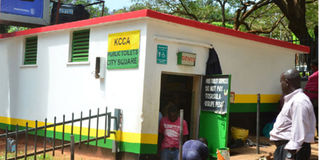Toilet crisis hits city slums

Kampala- Residents in Kampala slums are struggling to cope with life without toilets as the population increases.
Kampala’s slum occupants say they have severally asked for a solution but little or almost no response comes from the Kampala Capital City Authorities (KCCA).
The Nsooba East Village chairperson in Mulago III in lower end of Kamwokya in Kawempe Division says there are only five toilets serving more than 3,000 residents.
“We badly need toilets because as people in the ghetto (slums), we don’t have a definite number of children we give birth to. You find that once one gets poor, he or she resorts to producing children,” Mr Herman Katongole said.
Mr Katongole said the facilities built by KCCA have since filled up and were shut down.
“The latest toilets were constructed in 2002 and yet they are out of use now. We were forced to close those that had filled up to and find other means,” Mr Katongole said.
Risks
Mr Katongole said: “We have all kinds of toilets. Some people use the drainage trenches, pit-latrines and also the full ‘flying toilets’ where one eases into a polythene bag, throws it over his house.”
This, he said accounts for infections and diseases in the slums.
Mr Katongole said more than 10 families are using one facility at a time.
Mr Joseph Mukisa, a resident of Kalwere, said the last toilet constructed by the KCCA in 2002 had since filled up and collapsed.
“We now use polythene bags and we wait for night hoursto throw them into the trenches,” Mr Mukisa said.
It is for this reason the residents through the leadership of the Ghetto Research Lab and its Chief Executive Officer, Mr Patrick Mujjuzi, took up the initiative to champion the drive of constructing toilets.
“After noticing that our leaders were reluctant to help us, we decided to lead the campaign for the change we want,” Mr Mujjuzi said.
Intervention
Mr Rajiv Ruparelia, a trustee in the Ruperelia Foundation, a charity organisation that annually organises Goat Race to help raise funds for a charity cause, said this year’s proceeds have been channelled to build toilets for people in slums.
“This year, we have decided to help Mr Patrick [Mujuzi] and the Ghetto Research Lab which is building toilets through the slums,” Mr Rajiv said.
He was speaking at the ground-breaking ceremony of toilet construction for Six-unit toilets at the Good Samaritan Primary School in Kamwokya.
“We have inaugurated for the school that has 500 children to be able to have their own toilets and their teachers as well. We are starting with schools in the ghetto because they are a priority and without education we can’t help the society. Education is fundamental for any society in the world,” Mr Rajiv said.
Schools struggle
The head teacher of Good Samaritan Primary School in Kamwokya, Mr Noah Isisila, said for the last 18 months, his school has been operating without a toilet and yet their calls to the KCCA administration have not yielded.
“We now appeal to you to help us because our families are struggling,” Mr Isisila said.
He added: “Our children can’t keep in school because of the absence of toilets.”
Background
Statistics. On November 19, as the world marked the World Toilet Day, Water Aid and KCCA in conjunction with the Ministry of Health released a report indicating that more than 83.6 per cent of the schools in Kampala lack menstrual hygiene facilities for the Persons with Disabilities (PWDs).
Leaders respond. The country director of Water Aid-Uganda, Ms Jane Sembuche, faulted the absence of the right facilities on the reluctance of leaders.
“As NGOs, we are not going to be able to individually replace the government. We are there to support but the result will be achieved through leaders such as MPs, mayors and other policy makers to push the desired the change,” Ms Sembuche advised.



